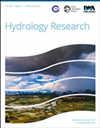A comprehensive method to estimate flood levels of rivers subject to ice jams: a case study of the Chaudière River, Québec, Canada
IF 2.4
4区 环境科学与生态学
Q2 Environmental Science
引用次数: 1
Abstract
The main difference between an open-water (regular) flood and an ice jam flood is that it is normally the whole river length that is overtopped whereas an ice jam flood is localized to where the jam is located. Comparatively, the regular flood analysis can use the value of the extreme discharge as the main input parameter for a long river section, an ice jam flood needs to account for the probability of jams of various lengths and intensities occurring at specific locations under significantly variable discharges while having several mechanical ice parameters to be considered. Through the case study of the Chaudière River, the methodology presented in this paper demonstrates how to statistically characterize four significant inputs (jam location, jam length, jam properties and river discharge during jam event) into the widely used numerical river water model (HEC-RAS) and how Monte–Carlo simulations are generated to estimate probable ice jam floods along a whole river reach. The purpose of this article is to propose a robust methodology through a case study and asses the sensitivity that historical and mechanical parameters have as to why specific locations along the reach have higher 1:100 AEP ice-induced water levels as to 1:100 AEP open-water levels.估算受冰塞影响的河流洪水水位的综合方法:以加拿大quacimubec的chaudi re河为例
开放水域(常规)洪水和冰塞洪水之间的主要区别在于,通常是整个河流长度被漫过,而冰塞洪水则局限于堵塞位置。相比之下,常规洪水分析可以使用极端流量值作为长河段的主要输入参数,冰塞洪水需要考虑在流量显著变化的情况下,在特定位置发生不同长度和强度的冰塞的概率,同时需要考虑几个机械冰参数。通过对Chaudière河的案例研究,本文提出的方法演示了如何在统计上表征广泛使用的河水数值模型(HEC-RAS)的四个重要输入(堵塞位置、堵塞长度、堵塞特性和堵塞事件期间的河流流量),以及如何生成蒙特卡罗模拟来估计整个河段可能发生的冰塞洪水。本文的目的是通过案例研究提出一种稳健的方法,并评估历史和机械参数对河段沿线特定位置为什么具有比1:100 AEP开放水位更高的1:100AEP冰诱导水位的敏感性。
本文章由计算机程序翻译,如有差异,请以英文原文为准。
求助全文
约1分钟内获得全文
求助全文
来源期刊

Hydrology Research
Environmental Science-Water Science and Technology
CiteScore
5.30
自引率
7.40%
发文量
70
审稿时长
17 weeks
期刊介绍:
Hydrology Research provides international coverage on all aspects of hydrology in its widest sense, and welcomes the submission of papers from across the subject. While emphasis is placed on studies of the hydrological cycle, the Journal also covers the physics and chemistry of water. Hydrology Research is intended to be a link between basic hydrological research and the practical application of scientific results within the broad field of water management.
 求助内容:
求助内容: 应助结果提醒方式:
应助结果提醒方式:


